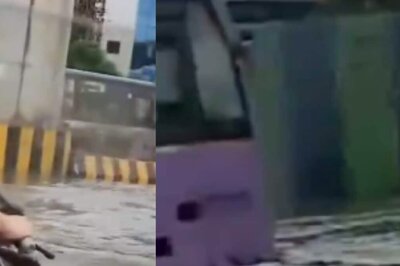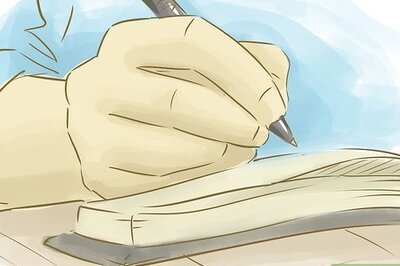
views
Using Paint Stripper to Remove Paint from Large Surface Areas
Cover your workspace with drop cloths or plastic sheets. When the paint starts to strip, it will come off in small strips and flakes. These little pieces will make a mess of whatever surface you're standing on. Attach the drop clothes or sheets to the floor or ground nearest the brick you want to clean with painter's tape or masking tape to prevent them from moving around (you can also weigh them down with bricks or other heavy objects). This method is effective for removing latex and oil-based paints, including sprays and acrylics. Cover yourself with clothes you don't mind getting dirty, gloves, a mask, and goggles. The mask and goggles will help protect you from the paint stripper chemical fumes, and the gloves will protect your skin from coming into contact with the harsh solvent. When using paint stripper indoors, open windows and turn on fans to ventilate the fumes out of your home. Put children and pets in rooms on the other side of the house, if possible, or only use the paint stripper when they're out of the house (i.e., the children are at school or staying with their grandparents and the pets are outside).
Test the paint stripper on a small, out-of-the-way area. Your brick may react differently to the paint stripper depending on its age and overall condition. To make sure the paint stripper will actually lift the paint and not discolor or otherwise damage the masonry underneath, apply a small amount of it to a small, out-of-the-way area of the painted brick. Avoid stripping the paint on brick older than 1978. Before that year, many home paints contained lead in them. Removing them can be dangerous to your health, so call a professional lead abatement contractor to take care of it for you.
Apply layers of paint stripper onto the painted brick with a trowel. Paint stripper typically comes in a bucket as a gel or a paste. Use a finishing trowel to scoop the product out of the container and build up a thick layer of it over the brick up to the thickness recommended by the paint stripper manufacturer. Push the product into all the crevices, holes, and gaps in the masonry to ensure the coating covers each individual painted brick as much as possible.
Stick sheets of laminated paper to the paint stripper (optional). Gently press laminated paper sheets to the paint stripper layer and overlap each sheet so the entire face of the painted brick is covered. Tape the edges of the paper with masking or painter's tape to keep it from blowing away or falling off. The paper keeps the paint stripper from drying out before it can penetrate through the paint layers. It also makes some of the paint easier to peel off.
Let the paint stripper cure for at least 15 minutes (or 24 hours with paper). If you didn't use laminated paper sheets to keep the paint stripper wet, let the paint stripper cure for at least 15 minutes (or however long the manufacturer recommends) before you start scraping it off. If you stuck laminated paper to the paint stripper layer, let it cure for a full 24 hours before peeling the paper back.
Scrape or scrub the paint stripper and paint off the brick. If you used laminated paper, slowly peel the sheets off and discard them. After that – or if you didn't use paper – use a metal putty knife to scrape the remaining paint off the brick. Remove stubborn pieces of paint by scrubbing them with a stiff bristle brush and water. This is typically a long process, so be prepared to scrape or brush the paint for a long time to get rid of all or most of it. Make sure to remove all traces of paint stripper from the brick if you plan on painting over it again. Any paint stripper that remains will prevent paint from adhering to that area.
Using Vinegar to Remove Paint from Small Surface Areas
Soak the painted brick in distilled white vinegar. Put on rubber kitchen gloves and then pour the vinegar onto the area where you want to strip paint. Alternatively, if the surface is vertical, you can use a sponge or bristle brush to spread the vinegar onto the masonry. Let it soak in for at least 2-3 minutes. This method works best for removing oil-based paint.
Scrub the vinegar-soaked brick with steel wool for at least 20 minutes. Scrub the area with steel wool for up to 20 minutes or longer if needed. Clean any remaining paint and vinegar residue with a wet rag or gently rinse it with a hose (if you're outside).
Paint Removal Methods to Avoid
Pressure washing and sandblasting. Some people online suggest using a pressure washer or sandblaster to remove paint. However, experts recommend avoiding these methods because they could cause irreversible damage to your masonry (especially if it's old or already in poor condition).
Heat guns. The heat from heat guns can sometimes work to remove paint from masonry. However, the process is extremely slow and labor-intensive, as it involves exposing the paint to heat for a long time and meticulously scraping up the loosened paint. Experts typically don't recommend it as an effective paint stripper. In addition, high heat interacts badly with certain paints, particularly old paint with a lead base. Avoid exposing lead-based paint to heat or you could start a fire with it.

















Comments
0 comment